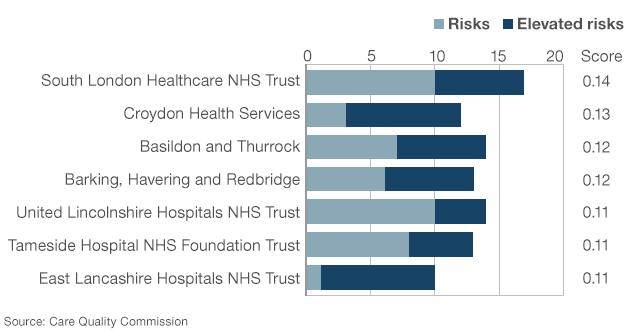Quarter of hospitals 'at raised risk of poor care'
- Published
Sir Mike Richards from the Care Quality Commission said the screening tool would help identify higher risk hospitals
A quarter of hospital trusts in England are at raised risk of providing poor care, a review by the regulator shows.
The findings are based on monitoring by the Care Quality Commission (CQC) of a host of data, including death rates, serious errors and patient surveys.
It found 44 out of 161 trusts fell into the two highest risk categories.
The exercise has been carried out as part of the regulator's new hospital inspection regime, which will see inspectors go into every trust by 2015.
The first inspections got under way in September and by Christmas the first 18 will have been completed.
It will result in every trust being given a rating of either 'outstanding', 'good', 'requires improvement' or 'inadequate' as part of a shake-up in the system ordered after the Stafford Hospital scandal.
The CQC said the latest information, external was not a final judgement, but would be used to prioritise which trusts to inspect earlier in the process.
Hospital chief inspector Prof Sir Mike Richards likened the risk review to a form of "screening".
He added: "Our intelligent monitoring helps to give us a good picture of risk within trusts, showing us where we need to focus our inspections."
The regulator has assessed each trust's performance against up to 150 different indicators.
Those performing worse than would be expected on each indicator get marked down as being at risk or elevated risk for that topic.
The number of risk scores they have determines which of the bands they are placed in.
Bands one and two - those at highest risk - include 24 trusts and 20 trusts respectively.
The trusts in band one include the 11 trusts already placed in special measures after a review of high mortality rates.
They are joined by Croydon Health Services, which was rated high risk in 12 areas for issues such as patient survey results and whistle-blowing.
Also in band one are Barking, Havering and Redbridge, which was rated high risk in 13 areas including A&E waits and patient surveys, and Aintree, rated high risk in 11 areas including an elevated risk for mortality rates.
How the highest risk trusts compare

Health Foundation chief executive Dr Jennifer Dixon, who is also a CQC board member, said: "It makes sense to use the wealth of routinely available data in the NHS to try to spot patterns which might identify or predict poor quality care for patients.
"The intelligent monitoring tool can never by itself be a crystal ball, but it is a great start and will surely develop over time."
Dr Mark Porter, head of the British Medical Association, said publishing the data was an "important step" towards improving transparency across the NHS, informing and empowering patients and identifying under-performing hospitals.
Dr Mark Porter, Chair of the BMA, said the review was an "important step for the NHS"
But he added: "Hospitals are large, complex organisations so we need to avoid oversimplifying or reducing vast amounts of data to a simple band or rating."
Labour Shadow Health Minister Jamie Reed said: "David Cameron should be ashamed that he's put so many of England's hospitals in this position.
"He siphoned £3bn out of the NHS front-line to blow on a back-office re-organisation nobody voted for. Hospitals were left on a financial knife-edge and they are clearly struggling to maintain standards of patient care after more than three years of chaos."
But Health Secretary Jeremy Hunt said: "Sadly, under the last government, a lack of transparency about poor care meant problems went unchecked for too long, some times with tragic consequences for patients.
"This government is being honest with the public about the quality of care at their local hospitals, and taking tough action where standards aren't up to scratch. Patients and staff deserve nothing less."
- Published17 September 2013
- Published18 July 2013
- Published16 July 2013
- Published24 October 2013